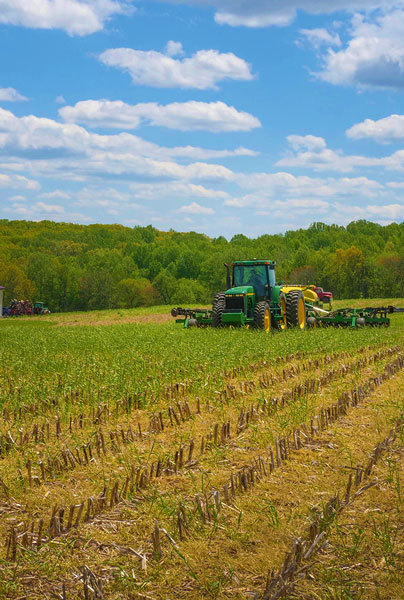Biogenic Emissions: Credit Where It's Due








PHOTO: UNITED STATES DEPARTMENT OF AGRICULTURE
August 12, 2020
BY Luke Geiver
An improved understanding of biogenic emissions from agricultural crops could change the economics of biobased product manufacturing and biofuel production. A major advocacy group, private industry players, and congressional members from both sides of the aisle are all pushing the U.S. EPA for updates to the classification of the de minimis character of annual emissions from corn, soybeans and other crops. The entire bioeconomy, they all believe, stands to benefit if EPA reclassifies the qualities of biogenic emissions so the quantifiable value of ag production for energy, bioproducts, feed and food includes both what goes into feedstock production and harvest, and what comes out.
Victim of Inertia
According to the Biogenic CO2 Coalition, federal regulation currently ignores the life-cycle carbon benefits from crop-based feedstocks and instead treats carbon dioxide emissions from fermentation, agricultural processing, wastewater treatment and biomass combustion the same as fossil fuels. “This puts America’s farmers and rural economies at a severe disadvantage,” says John Bode, president and CEO of the Corn Refiners Association, an affiliate organization helping to lead the Biogenic CO2 Coalition.
Thomas Parks, senior communications manager for CRA and a spokesperson for the Biogenic CO2 Coalition, says no other country in the world regulates its ag-based emissions as if they are the same as fossil-based emissions.
The federal regulations administered through the EPA regarding biogenic emissions are not popular with the current administration, Bode says. And the Obama administration also did not believe regulations that placed ag-based emissions on the same level as fossil-based emissions were appropriate. Still, nothing changed.
Robin Bowen, vice president of external affairs for the Biogenic CO2 Coalition, says bureaucratic inertia is to blame for the government’s inaction on the issue. “There is no scientific or political reason for EPA’s current policy,” Bowen says. “It’s nothing more than an oversight that has taken far too long to address, and we have an opportunity to get action on it now.”
Bowen, along with coalition members and a bipartisan group of U.S. lawmakers, is working for change this year. In early June, the coalition wrote a letter to EPA, calling for the agency to allow public comment on the regulations of biogenic emissions for annual agricultural crops. Last year, five governors and six senators also wrote letters or publicly called on EPA to address the same biogenic emissions regulations. Soon, EPA is expected to change its stance on the emissions specifically from woody biomass, differentiating them from fossil-based emissions, a move that Bode says is welcome but not enough for the ag sector.
Senator Mike Braun, R-Ind., along with Debbie Stabenow, D-Mich.; Lindsey Graham, R-S.C.; and Sheldon Whitehouse, D-R.I., introduced the Growing Climate Solutions Act in early June to make sure EPA doesn’t forget about the ag sector. The bill aims to break down barriers for farmers and foresters interested in participating in carbon markets so they can be rewarded for climate-smart practices.
Bowen says the Growing Climate Solutions Act is an important step toward recognizing agriculture as a critical tool in the fight against climate change. That is part of the main focus of Bowen and her team: Help illuminate the potential for agriculture as a tool and resource in the fight against climate change. “This bill seeks to reward the continuous efforts of farmers to improve the sustainability and greenhouse gas sequestration abilities of their operations. CRA stands firmly in support of this critical step toward removing the serious technical and logistical barriers preventing American farmers from participating fully in market-based solutions to climate change.”
Advertisement
Advertisement
The results from multiple scientific studies shows why so many groups are working in unison with members of Congress to change the way biogenic emissions are viewed and regulated. “Multiple scientific studies have stated that biogenic carbon emissions from facilities that process agricultural feedstocks do not contribute to long-term increases in atmospheric greenhouse gases,” says Eamon Monahan, senior director of environmental affairs and workplace safety for CRA. Whereas fossil fuels pull carbon deep in the ground that is millions of years old and releases it into the atmosphere, agricultural crops absorb carbon during the growing process, and release it back into the atmosphere six to 12 months later as part of a relatively rapid natural cycle, Monahan adds.
“Everybody gets it,” Bode says bluntly, “now we just need to get that recognized.”
Immediate Impact
American agriculture has been hit hard by the COVID-19 pandemic. “With crop prices and farm incomes in freefall, EPA has a critical opportunity to act swiftly to unleash more than a billion dollars in new investments and return the focus to job growth in the American heartland,” Bowen says. It would also enable U.S. businesses to compete in the international marketplace for renewable products, he adds.
America’s bioeconomy currently contributes $459 billion in economic activity, provides 4.6 million American jobs and is the leading source of domestic renewable energy in the U.S., Bowen points out. “Yet, we are falling behind in the international marketplace for renewable products and materials.”
The value of the bioeconomy in the EU, by comparison, is $671 billion and it employs 18 million people.
Bode says ethanol can be a significant feedstock for advanced bioproducts. “So, correcting EPA’s biogenic CO2 policy, which only is concerned with stationary sources and has no bearing on the RFS,” he says, “could provide flexibility for ethanol producers to better serve emerging markets.”
The regulatory burden currently associated with biogenic emissions in the U.S. can be tough on corn wet mills and other corn-based processing facilities, Bode says. In some cases, the regulations can deter expansion or new project buildouts by one to two years. “That can be a major burden.
Elimination of that regulatory obstacle would improve investment in the bioeconomy here,” he says. The elimination of the regulation would help investment move faster as the emissions from an annual biogenic crop source wouldn’t have to be monitored or accounted for in the same costly way as fossil-based emissions.
Bowen and Bode agree that there is also a larger benefit to changing the way the U.S. regulates, and views, biogenic emissions from annual agriculture crops. For the last four years, the CRA and some of its members from the Biogenic CO2 Coalition have attended global summits on climate change.
Advertisement
Advertisement
According to Bode, the goal is to understand how the global community, along with the biobased industry, views agriculture as a positive force in the fight against climate change—as opposed to a hurdle. Bowen believes the U.S. agriculture industry is gaining more recognition for the role it plays in addressing climate change, but Bode says there is more to be done.
Advancing the environmental profile and usefulness of ag-based products is important, Bode says. Creating a better image of corn is important. “The consumer is becoming increasingly distant from agribusiness,” he says. “There is significant value on a larger scale in changing the way we view or regulate biogenic emissions from ag products.”
Smart Incentives
One of the main elements of the Growing Climate Solutions Act was its focus on rewarding climate-smart practices. The bill is trying to create a USDA certification program to help solve issues for farmers and ranchers trying to participate in carbon credit markets. That program, the Greenhouse Gas Technical Assistance Provider and Third-Party Verifier Certification Program, would enable the USDA to provide transparency, legitimacy and information endorsement of third-party verifiers and technical service providers that help private landowners generate carbon credits through a variety of agriculture- and forestry-related practices. The USDA certification program would aim to ensure that these assistance providers have agriculture and forestry experience. The agency would also administer a new website that would serve as a one-stop shop of information and resources for producers and foresters who are interested in participating in carbon markets.
Jason Weller, vice president of Truterra LLC, spoke to the senators during the Growing Climate Solutions Act hearing. Weller said the legislation would help biofuels producers in the same way it would help biobased product producers. Those in the energy supply chain need to have the necessary data to demonstrate GHG savings in order to generate credits under those programs. With a system in place that established the value of carbon credits—and the practices needed to create them—farmers or biofuel producers could move to adopt a new suite of technologies, conservation practices or new machinery needed to create GHG reductions that meet marketplace objectives.
Zippy Duvall, president of the American Farm Bureau Federation (the AFBF is also a member of the Biogenic CO2 Coalition), also told senators that it is vital for the greater ag industry to have greenhouse gas emissions modeling that can be trusted and depended on.
The USDA has also created its own unique GHG modeling and tracking system that will help American farmers participate in a market that values its biogenic emissions. Developed in part by Colorado State University, the COMET Farm system is a whole farm and ranch carbon and greenhouse gas accounting platform. The system includes a tool that helps users describe their property management practices while also allowing for future management change scenarios. A report can be generated showing the carbon and GHG emissions profile and potential from current or future scenarios. This past November, the team behind COMET updated its system. The platform’s newest version (2.3) has an enhanced method for calculating a farm’s soil N2O level. The system also has new and improved modules that track and calculate synthetic fertilizer, organic fertilizer and the impacts of manure. The only information needed to use the COMET system is related to field or livestock management practices. The field module will ask for crop practices starting from roughly the year 2000, including cropping sequence, approximate planting and harvest dates, tillage systems, fertilizer application information, irrigation methods and residue managements.
An additional energy module is available that applies to the use of renewable energy at a facility or farm. According to the USDA, the system uses information on management practices together with spatially explicit information on climate and soil conditions from USDA databases—provided automatically in the tool—to run a series of models for each potential source of greenhouse gas emissions.
Regardless of the biogenic emission tracker or data organization system used, Bode and his team believe the focus should remain on two areas: understanding and accuracy. With the support of the current administration (along with the previous administration), congressional leaders and multiple ag-sector leaders, the Biogenic CO2 Coalition will continue to seek changes to how biogenic emissions are regulated. Annual crop production efforts, and the emissions generated, should not be regulated the same as the fossil fuel industry. The science proves it, Bode says. And, as the efforts to push the EPA to change its stance on biogenic emissions continue pushing upstream against the bureaucratic inertial Bowen points to, there's a notable overall theme. The ag sector and the biofuel production sector should be seen as a positive asset in the climate change conundrum, he says. This year, the CRA adopted a set of climate change policy principles to guide the industry’s advocacy to ensure a more sustainable future for corn refining, agriculture and consumers. “The principles include undertaking initiatives to reduce the overall carbon footprint of corn refining products and processes, an embrace of GHG reduction goals that are both achievable and science-based and recognizing agricultural feedstocks in industrial processes as a key element in advancing GHG reductions,” he says.
Moving ahead, Bode says, he hopes consumers embrace, rather than discredit, the full value of ag in food, feed, fuel and other biobased products.
Author: Luke Geiver
Associate Editor, Ethanol Producer Magazine
701.738.4944
lgeiver@bbiinternational.com
Related Stories
The USDA significantly increased its estimate for 2025-’26 soybean oil use in biofuel production in its latest World Agricultural Supply and Demand Estimates report, released July 11. The outlook for soybean production was revised down.
U.S. fuel ethanol capacity fell slightly in April, while biodiesel and renewable diesel capacity held steady, according to data released by the U.S. EIA on June 30. Feedstock consumption was down when compared to the previous month.
The U.S. EPA on July 8 hosted virtual public hearing to gather input on the agency’s recently released proposed rule to set 2026 and 2027 RFS RVOs. Members of the biofuel industry were among those to offer testimony during the event.
The U.S. exported 31,160.5 metric tons of biodiesel and biodiesel blends of B30 and greater in May, according to data released by the USDA Foreign Agricultural Service on July 3. Biodiesel imports were 2,226.2 metric tons for the month.
The USDA’s Risk Management Agency is implementing multiple changes to the Camelina pilot insurance program for the 2026 and succeeding crop years. The changes will expand coverage options and provide greater flexibility for producers.
Upcoming Events










